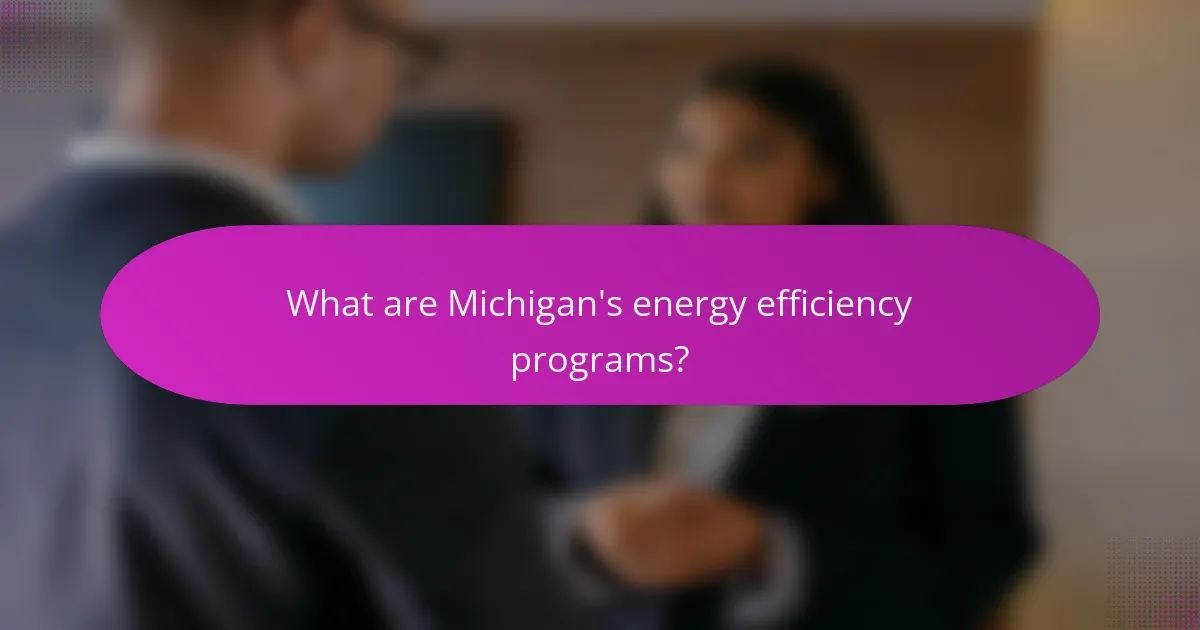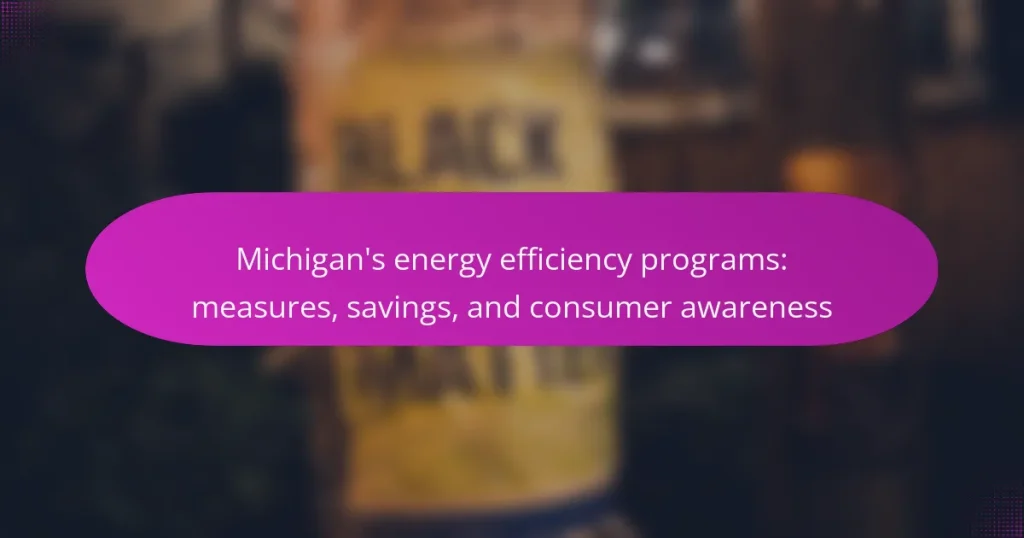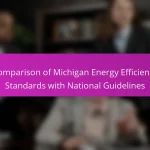
What are Michigan’s energy efficiency programs?
Michigan’s energy efficiency programs aim to reduce energy consumption and promote sustainable practices. These programs include initiatives for residential, commercial, and industrial sectors. The Michigan Public Service Commission oversees many of these efforts. Programs often provide incentives for energy-efficient appliances, lighting, and HVAC systems. Additionally, they offer rebates and financial assistance for energy audits. According to the Michigan Energy Efficiency Program, these initiatives have saved consumers billions in energy costs. They also contribute to reducing greenhouse gas emissions statewide. Overall, Michigan’s energy efficiency programs support both economic and environmental goals.
How do these programs aim to improve energy efficiency?
These programs aim to improve energy efficiency by implementing various strategies and measures. They promote the adoption of energy-efficient appliances and technologies. Incentives are provided to encourage consumers to upgrade to more efficient systems. Educational initiatives raise awareness about energy-saving practices. The programs also conduct energy audits to identify areas for improvement in homes and businesses. Additionally, they offer rebates and financial assistance to lower the cost of energy-efficient upgrades. According to the Michigan Public Service Commission, these efforts have led to significant reductions in energy consumption across the state.
What specific measures are included in Michigan’s energy efficiency programs?
Michigan’s energy efficiency programs include measures such as home energy audits, insulation upgrades, and heating system improvements. These programs also offer incentives for energy-efficient appliances and lighting. Additionally, they provide rebates for smart thermostats and energy-efficient windows. The goal is to reduce energy consumption and lower utility costs for residents. According to the Michigan Public Service Commission, these measures have led to significant energy savings statewide. In 2020 alone, energy efficiency programs saved over 1.5 billion kilowatt-hours of electricity.
How do these measures impact residential and commercial energy use?
Energy efficiency measures significantly reduce residential and commercial energy use. These measures include insulation improvements, efficient lighting, and HVAC upgrades. For example, homes with enhanced insulation can see energy savings of 20-30%. Commercial buildings that adopt LED lighting can reduce energy consumption by up to 75%. According to the Michigan Public Service Commission, energy efficiency programs saved over 1.3 billion kilowatt-hours in 2020 alone. These savings translate to lower utility bills for consumers and reduced overall energy demand. Implementing such measures contributes to a more sustainable energy future in Michigan.
What savings can consumers expect from participating in these programs?
Consumers can expect significant savings from participating in Michigan’s energy efficiency programs. These programs typically lead to reductions in energy bills ranging from 10% to 30%. For example, a household that spends $200 monthly on energy could save between $20 to $60 each month. Additionally, many programs offer rebates for energy-efficient appliances, further lowering costs. According to the Michigan Public Service Commission, residential energy efficiency measures can save consumers over $1 billion annually. These savings are achieved through improved insulation, energy-efficient lighting, and smart thermostats.
How are energy savings calculated for different measures?
Energy savings are calculated by comparing the energy usage before and after implementing efficiency measures. This involves measuring the baseline energy consumption of a specific system or appliance. After the efficiency measure is applied, the new energy consumption is recorded. The difference between the baseline and the new consumption indicates the energy savings achieved. For example, if a building used 1,000 kWh before installing energy-efficient lighting and 600 kWh afterward, the energy savings would be 400 kWh. This calculation helps quantify the effectiveness of various energy efficiency measures in Michigan’s programs.
What financial incentives are available for consumers?
Consumers in Michigan can access various financial incentives for energy efficiency improvements. These incentives include rebates for energy-efficient appliances, home energy audits, and insulation upgrades. Utility companies often provide these rebates to encourage energy-saving measures. Additionally, state and federal tax credits may be available for specific energy-efficient installations. Programs like the Michigan Saves program offer low-interest loans for energy upgrades. According to the Michigan Public Service Commission, these incentives aim to reduce energy consumption and lower utility bills for consumers.
Why is consumer awareness important in Michigan’s energy efficiency initiatives?
Consumer awareness is crucial in Michigan’s energy efficiency initiatives because it drives participation and engagement. When consumers understand energy-saving options, they are more likely to adopt energy-efficient practices. Increased awareness leads to higher enrollment in programs that offer rebates and incentives. According to the Michigan Public Service Commission, informed consumers can reduce energy consumption by up to 20%. This reduction not only lowers utility bills but also contributes to state-wide energy goals. Furthermore, consumer feedback helps shape effective policies and programs. Engaged consumers advocate for sustainable practices, fostering a culture of energy efficiency.
How does consumer education influence participation rates?
Consumer education significantly influences participation rates in Michigan’s energy efficiency programs. Educated consumers are more likely to understand the benefits of energy efficiency measures. This understanding leads to increased willingness to participate in programs. Research shows that informed consumers are 30% more likely to engage in energy-saving initiatives. Additionally, educational outreach enhances awareness of available incentives. Consumers who receive information about savings potential are more inclined to take action. Effective consumer education can lead to higher participation rates and greater overall energy savings.
What resources are available to help consumers understand these programs?
Consumers can access various resources to understand Michigan’s energy efficiency programs. The Michigan Public Service Commission provides detailed guides and FAQs on their website. Local utility companies also offer information through customer service representatives and online resources. Non-profit organizations frequently conduct workshops and webinars to educate the public. Additionally, state-sponsored outreach campaigns disseminate brochures and materials in community centers. The Energy Star website features tools and tips tailored to energy efficiency. These resources collectively aim to enhance consumer awareness and comprehension of available programs.
How do Michigan’s energy efficiency programs compare to those in other states?
Michigan’s energy efficiency programs are among the most robust in the United States. The state mandates energy efficiency standards for utilities, requiring them to achieve specific savings targets. According to the American Council for an Energy-Efficient Economy (ACEEE), Michigan ranks 10th in the nation for energy efficiency policies and programs. This ranking reflects the state’s commitment to reducing energy consumption and promoting sustainable practices.
In comparison to other states, Michigan’s programs emphasize residential and commercial energy savings. The state offers various incentives, including rebates and low-interest loans, to encourage participation. Additionally, Michigan’s energy efficiency programs have led to significant savings, with estimates suggesting over 1 billion kWh saved annually.
This performance is comparable to states like California and Massachusetts, known for their aggressive energy efficiency initiatives. However, Michigan faces challenges, such as funding limitations and varying levels of consumer awareness. Overall, Michigan’s energy efficiency programs are competitive and contribute to the state’s energy conservation goals.
What best practices can be learned from other states’ programs?
Best practices from other states’ energy efficiency programs include comprehensive stakeholder engagement, clear communication strategies, and robust evaluation metrics. States like California have successfully implemented extensive outreach campaigns that educate consumers on energy-saving measures. Their programs emphasize collaboration between utilities, government agencies, and community organizations. This approach fosters trust and increases participation rates. Additionally, states such as Massachusetts utilize data-driven evaluations to measure program effectiveness and optimize resource allocation. These evaluations inform future program designs and ensure continuous improvement. By adopting these strategies, Michigan can enhance its energy efficiency initiatives and maximize consumer awareness and savings.
How do program outcomes vary across different regions?
Program outcomes in Michigan’s energy efficiency initiatives vary significantly across different regions. Factors influencing these variations include local energy needs, climate conditions, and economic contexts. For instance, urban areas may show higher participation rates due to greater awareness and access to resources. Rural regions might experience lower engagement due to limited outreach and infrastructure. Additionally, program effectiveness can differ based on the availability of incentives and support services. Data from the Michigan Public Service Commission indicates that regions with targeted marketing strategies yield better savings outcomes. This evidence highlights the importance of tailored approaches to maximize program effectiveness across diverse geographic areas.
What are the challenges and barriers to implementing energy efficiency programs?
The challenges and barriers to implementing energy efficiency programs include high upfront costs, lack of consumer awareness, and insufficient incentives. High initial investment deters many homeowners and businesses from upgrading to energy-efficient technologies. According to a 2020 report by the American Council for an Energy-Efficient Economy, nearly 70% of consumers cite costs as a significant barrier. Lack of awareness leads to misconceptions about energy efficiency benefits. Many consumers do not understand the long-term savings associated with energy-efficient upgrades. Insufficient incentives from utility companies can also limit participation in programs. Without attractive rebates or financing options, potential participants may not engage with energy efficiency initiatives. Additionally, regulatory hurdles can complicate program implementation, creating delays and increasing costs. These factors collectively hinder the effectiveness of energy efficiency programs in Michigan.
How do economic factors affect program participation?
Economic factors significantly influence program participation in Michigan’s energy efficiency initiatives. Individuals with lower income levels may find it challenging to invest in energy-efficient upgrades. Economic constraints can limit access to information about available programs. Additionally, high upfront costs deter participation, even when long-term savings are evident. Conversely, financial incentives and rebates can enhance participation rates. For instance, programs offering subsidies have seen increased enrollment. Economic stability often correlates with higher engagement in energy efficiency efforts. Studies indicate that households experiencing financial strain are less likely to enroll in such programs. Thus, economic factors play a critical role in shaping participation in energy efficiency programs.
What are common misconceptions about energy efficiency programs?
Common misconceptions about energy efficiency programs include the belief that they are too expensive. Many people think that the initial costs outweigh the long-term savings. However, studies show that energy efficiency measures often pay for themselves over time through reduced utility bills. Another misconception is that these programs are only for low-income households. In reality, energy efficiency programs are designed for all income levels. Many middle and upper-income households also benefit from these initiatives. Additionally, some individuals believe that energy efficiency improvements require significant lifestyle changes. In fact, many measures are simple upgrades that do not disrupt daily routines. Lastly, there is a misconception that energy efficiency programs do not significantly impact the environment. In truth, reducing energy consumption lowers greenhouse gas emissions and contributes to a healthier planet.
What practical steps can consumers take to maximize savings from these programs?
Consumers can maximize savings from Michigan’s energy efficiency programs by following specific steps. First, they should conduct a home energy audit. This audit identifies areas where energy is wasted. Second, consumers should take advantage of rebates offered for energy-efficient appliances. These rebates can significantly reduce upfront costs. Third, participating in demand response programs can lower energy bills. These programs encourage reduced energy use during peak times. Fourth, consumers should regularly maintain their heating and cooling systems. Proper maintenance ensures these systems operate efficiently. Lastly, enrolling in energy efficiency workshops can provide valuable tips and resources. These steps can lead to substantial savings on energy costs.
Michigan’s energy efficiency programs focus on reducing energy consumption and promoting sustainable practices across residential, commercial, and industrial sectors. These initiatives, overseen by the Michigan Public Service Commission, offer incentives such as rebates for energy-efficient appliances, energy audits, and financial assistance for upgrades. The programs have resulted in significant energy savings, contributing to lower utility bills and reduced greenhouse gas emissions statewide. Consumer awareness and education play a crucial role in driving participation, while various challenges, including economic factors and misconceptions, affect engagement levels. This overview highlights the measures, savings potential, and importance of consumer involvement in Michigan’s energy efficiency efforts.


